Hemerocallidoideae
Hemerocallidoideae is the botanical name of a subfamily of flowering plants, part of the family Asphodelaceae sensu lato in the monocot order Asparagales according to the APG system of 2016.[1] Earlier classification systems treated the group as a separate family, the Hemerocallidaceae. The name is derived from the generic name of the type genus, Hemerocallis. The largest genera in the group are Dianella (with 20 species), Hemerocallis (15), and Caesia (11).
| Hemerocallidoideae | |
|---|---|
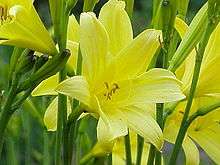 | |
| Hemerocallis | |
| Scientific classification | |
| Kingdom: | Plantae |
| Clade: | Tracheophytes |
| Clade: | Angiosperms |
| Clade: | Monocots |
| Order: | Asparagales |
| Family: | Asphodelaceae |
| Subfamily: | Hemerocallidoideae Lindley |
| Genera | |
|
See text | |
In the 21st century, the group has had two basic forms, depending on whether Johnsonia and its relatives are included or not. Each of these forms can vary by the inclusion or exclusion of Xeronema. If defined narrowly, most of the group are native to tropical and temperate Eurasia and Australia. They also occur in New Zealand, many Pacific islands, western South America, and Madagascar, but not in Sub-Saharan Africa or North America.[2] If defined broadly, then the group includes the genus Caesia, which is indigenous to Southern Africa, as well as Australia.[3]
The APG III system of 2009 used the broader definition of the group,[4] treating it as the subfamily Hemerocallidoideae of the family Xanthorrhoeaceae sensu lato.[5] In the APG IV system of 2016 the name Asphodelaceae is used in preference to Xanthorrhoeaceae.[1]
Hemerocallis fulva is a common ornamental. Other species of Hemerocallis are cultivated as well. Hemerocallis citrina has medicinal uses. Phormium tenax is a source of fiber in New Zealand.
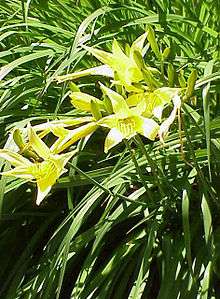
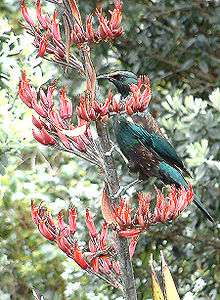
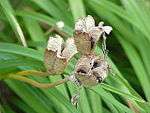
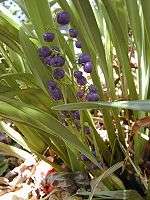
Circumscription
Some of the older systems included Xeronema in Hemerocallidaceae, but with considerable doubt about whether it really belonged there.[6] Molecular phylogenetic studies of DNA sequences have shown that Xeronema is sister to a clade consisting of Asphodelaceae sensu lato, Amaryllidaceae sensu lato, and Asparagaceae sensu lato.[7] Xeronema is now placed in its own family, Xeronemataceae.[4]
In 1985, Dahlgren, Clifford, and Yeo produced a work on monocot taxonomy that remained influential for over two decades.[8] They defined Hemerocallidaceae as consisting only of Hemerocallis. They excluded Phormium and its relatives, placing them into a separate family, Phormiaceae. This treatment was followed by Armen Takhtajan in 2009, in a classification that was based almost entirely on morphology and that recognized paraphyletic groups. It was not followed in a major work on monocot taxonomy which appeared in 1998.[9]
In the 21st century, Hemerocallidaceae has been defined in essentially two different ways in systems based on monophyletic groups.[2] In the narrower of these circumscriptions, Hemerocallidaceae sensu stricto, it consists of 12 genera and 40 to 50 species.[6] It does not include the 8 genera and about 38 species that are placed in a separate family, Johnsoniaceae.[10]
The broader version of the family, Hemerocallidaceae sensu lato, includes those species that would otherwise be assigned to Johnsoniaceae. Johnsoniaceae and Hemerocallidaceae sensu stricto form a clade that has strong statistical support. One study found Johnsoniaceae to be embedded in Hemerocallidaceae sensu stricto, but this result did not have strong bootstrap support.[11]
The broader version of Hemerocallidaceae is the one that was accepted by the Angiosperm Phylogeny Group when they published the APG II system in 2003. When this system was superseded by APG III in 2009, Hemerocallidaceae was not recognized, instead being treated as subfamily Hemerocallidoideae of the expanded family Xanthorrhoeaceae sensu lato.[5] In the APG IV system of 2016 the name Asphodelaceae is used in preference to Xanthorrhoeaceae.[1]
For a phylogeny of Hemerocallidaceae, see the phylogenetic tree at Asphodelaceae.
Genera
As noted above, a broad circumscription of the group includes the two former families Hemerocallidaceae sensu stricto and Johnsoniaceae. The Kubitzki system of 1998 has 12 genera (not counting Xeronema) in Hemerocallidaceae and eight genera in Johnsoniaceae.[9] Some authors combine some of the more closely related genera, recognizing as few as three genera in Hemerocallidaceae sensu stricto and as few as one in Johnsoniaceae.[5] The genera listed below are from the World Checklist of Selected Plant Families, which recognizes 19 genera,[12] with the placement in the subfamily based on APWeb as of December 2010.
- Agrostocrinum F.Muell.
- Arnocrinum Endl.
- Caesia R.Br.
- Corynotheca F.Muell.
- Dianella Lam.
- Eccremis Willd.
- Geitonoplesium A.Cunn.
- Hemerocallis L.
- Hensmania W.Fitzg.
- Herpolirion Hook.f.
- Hodgsoniola F.Muell.
- Johnsonia R.Br.
- Pasithea D.Don
- Phormium J.R.Forst.
- Rhuacophila Blume – synonym of Dianella
- Stypandra R.Br.
- Simethis Kunth
- Stawellia F.Muell.
- Thelionema R.J.F.Hend.
- Tricoryne R.Br.
References
- Angiosperm Phylogeny Group (2016). "An update of the Angiosperm Phylogeny Group classification for the orders and families of flowering plants: APG IV". Botanical Journal of the Linnean Society. 181 (1): 1–20. doi:10.1111/boj.12385.
- Ole Seberg. 2007. "Hemerocallidaceae" pages 370-371. In: Vernon H. Heywood, Richard K. Brummitt, Ole Seberg, and Alastair Culham. Flowering Plant Families of the World. Firefly Books: Ontario, Canada. ISBN 978-1-55407-206-4.
- Ole Seberg. 2007. "Johnsoniaceae" page 376. In: Vernon H. Heywood, Richard K. Brummitt, Ole Seberg, and Alastair Culham. Flowering Plant Families of the World. Firefly Books: Ontario, Canada. ISBN 978-1-55407-206-4.
- Angiosperm Phylogeny Group (2009), "An update of the Angiosperm Phylogeny Group classification for the orders and families of flowering plants: APG III", Botanical Journal of the Linnean Society, 161 (2): 105–121, doi:10.1111/j.1095-8339.2009.00996.x, archived from the original on 25 May 2017, retrieved 10 December 2010
- Chase, Mark W.; Reveal, James L.; Fay, Michael F. (2009). "A subfamilial classification for the expanded asparagalean families Amaryllidaceae, Asparagaceae and Xanthorrhoeaceae". Botanical Journal of the Linnean Society. 161 (2): 132–136. doi:10.1111/j.1095-8339.2009.00999.x. ISSN 0024-4074.
- H. Trevor Clifford, Rodney J.F. Henderson, and John G. Conran. 1998. "Hemerocallidaceae" pages 245-253. In: Klaus Kubitzki (editor). 1998. The Families and Genera of Vascular Plants volume III. Springer-Verlag: Berlin;Heidelberg, Germany. ISBN 978-3-540-64060-8
- J. Chris Pires, Ivan J. Maureira, Thomas J. Givnish, Kenneth J. Sytsma, Ole Seberg, Gitte Petersen, Jerrold I. Davis, Dennis W. Stevenson, Paula J. Rudall, Michael F. Fay, and Mark W. Chase. 2006. "Phylogeny, genome size, and chromosome evolution of Asparagales". Aliso 22(Monocots: Comparative Biology and Evolution):287-304. ISSN 0065-6275.
- Rolf M.T. Dahlgren, H. Trevor Clifford, and Peter F. Yeo. 1985. The Families of the Monocotyledons. Springer-Verlag: Berlin, Heidelberg, New York, Tokyo. ISBN 978-3-540-13655-2. ISBN 978-0-387-13655-4.
- Klaus Kubitzki (editor). 1998. The Families and Genera of Vascular Plants volume III. Springer-Verlag: Berlin;Heidelberg, Germany. ISBN 978-3-540-64060-8
- H. Trevor Clifford, and John G. Conran. 1998. "Johnsoniaceae" pages 336-340. In: Klaus Kubitzki (editor). 1998. The Families and Genera of Vascular Plants volume III. Springer-Verlag: Berlin;Heidelberg, Germany. ISBN 978-3-540-64060-8
- Dion S. Devey, Ilia Leitch, Paula J. Rudall, J. Chris Pires, Yohan Pillon, and Mark W. Chase. "Systematics of Xanthorrhoeaceae sensu lato, with an emphasis on Bulbine". Aliso 22(Monocots: Comparative Biology and Evolution):345-351. ISSN 0065-6275.
- Search for "Xanthorrhoeaceae", World Checklist of Selected Plant Families, Royal Botanic Gardens, Kew, retrieved 25 February 2013
External links
| Wikimedia Commons has media related to Hemerocallidoideae. |
| Wikispecies has information related to Hemerocallidoideae |
- Hemerocallidoideae At: Angiosperm Phylogeny Website At: Missouri Botanical Garden Website
- Hemerocallidaceae, Phormiaceae in L. Watson and M.J. Dallwitz (1992 onwards). The families of flowering plants: descriptions, illustrations, identification, information retrieval. Version: 9 March 2006. http://delta-intkey.com
- Liliaceae in the Flora of North America
- NCBI Taxonomy Browser
- Hemerocallidaceae at CSDL and Phormiaceae at CSDL At: Texas A&M Bioinformatics Working Group